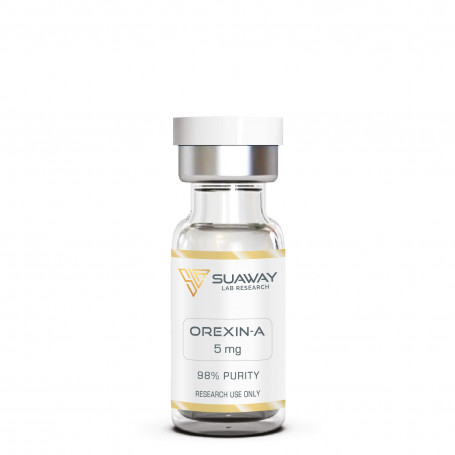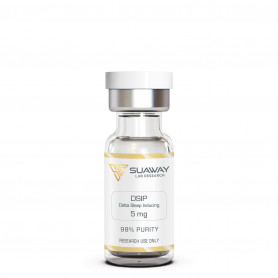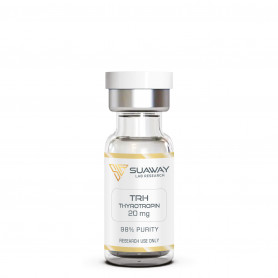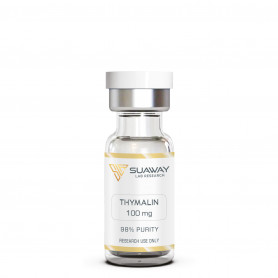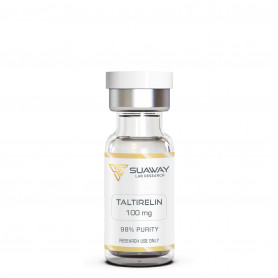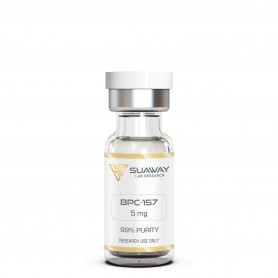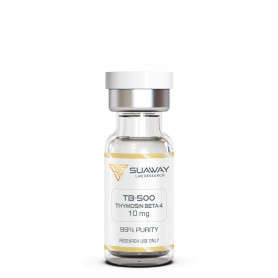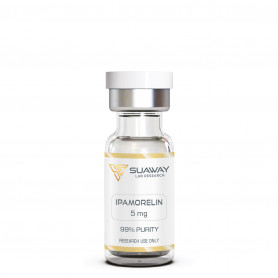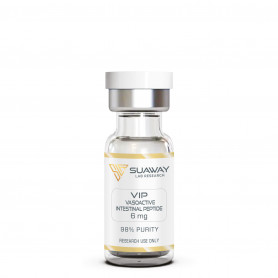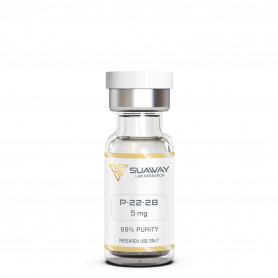Description
STRUCTURE
Sequence: Glp-Pro-Leu-Pro-Asp-Cys-Cys-Arg-Gln-Lys-Thr-Cys-Ser-Cys-Arg-Leu-Tyr-Glu-Leu-Leu-His-Gly-Ala-Gly-Asn-His-Ala-Ala-Gly-Ile- Leu-Thr-Leu-NH2 [Disulfide Bridges: 6-12; 7-14]
Molecular Formula: C152H243N47O44S4
Molecular Weight: 3561,1 g/mol
CAS: 205599-75-3
Peptide purity: greater than 98%
Other details: No TFA Salt
Storage: Lyophilized peptide must be stored at -20°C and peptide solution at 4°C.
Orexin-A has low oral and excellent subcutaneous bioavailability.
DESCRIPTION
In 1998, two groups searching for new signaling molecules independently discovered the orexin neuropeptides and their receptors. Sakurai, Yanagisawa, and colleagues named these peptides orexin-A and -B because they were originally thought to promote feeding (the term orexin comes from orexis, the Greek word for appetite). The team led by de Lecea and Sutcliffe named the peptides hypocretin-1 and -2 because they are produced in the hypothalamus and have some similarities to the incretin family of peptides. Over the past decade, it has become clear that although the orexin peptides have only a modest influence on feeding and appetite, their effects on arousal and sleep are profound. In fact, narcolepsy, one of the most common causes of sleepiness, is caused by a loss of the orexin-producing neurons, and this has fueled a strong interest in developing orexin antagonists as a novel approach for promoting sleep and treating insomnia.
Orexin A and B are peptides released by neurons of the lateral hypothalamus that play an important role in mediating wakefulness and arousal.
They are released during wakefulness and increase activity of the raphe nuclei, ventral tegmental area, tuberomammillary nucleus, and locus coeruleus – all of which promote wakefulness activation of various neurotransmitters (e.g., dopamine, norepinephrine, serotonin, and histamine). It is believed this subsequently prevents improper transitions into rapid eye movement (REM) and non-REM sleep and therefore, having deficiencies in these neuropeptides may induce abnormal sleep phenomena seen in narcolepsy such as sleep paralysis, cataplexy, and hypnagogic hallucinations. Ultimately, orexins may help regulate the sleep–wake cycles.
Approximately 90% of individuals diagnosed with narcolepsy with cataplexy have low or undetectable levels of orexin in their cerebrospinal fluid (CSF), which correspond to a paucity of hypothalamic neurons that produce the neuropeptide.
Because orexin is thought to play an important role in mediating wakefulness, blockade of orexin receptors is expected to enhance sleep and is a mechanism of interest for developing treatments for patients with insomnia.
As has already been said, Orexin and its cognate receptors (OX1R and OX2R) play a key role in sleep/wake regulation. This neurotransmitter system has a crucial involvement in the pathogenesis of narcolepsy, a disorder associated with chronic excessive daytime sleepiness, sleep attacks, and rapid transitions between vigilance states and sleep in humans.
Studies in mice not only demonstrated the role of orexin signaling in sleep/wake regulation but also demonstrated biological proof of concept for the development of orexin receptor antagonists for the treatment of insomnia.
In contrast, the activation of orexin pathways, either by exogenous administration of orexin receptor agonists or by optogenetic activation of orexinergic neurons in the lateral hypothalamus, increases arousal.
Orexinergic neurons are counteracted by inhibitory γ-aminobutyric acid (GABA)-ergic neurons originating from the ventrolateral preoptic nucleus (VLPO).
This peptide also regulates body temperature. The importance of this peptide (and/or associated co-neurotransmitters) in the maintenance of thermoregulatory homeostasis is indicated by a blunted hyperthermic response to cold exposure in mice with ablation of orexin neurons and may explain dysregulation of thermogenesis in individuals with narcolepsy.
Hypocretin-1 in vivo lumbar CSF concentrations have been studied in medication-overuse-headache and in chronic migraine, a disorder often accompanied by overuse of pain medication. In both patient groups, hypocretin-1 values were higher compared to controls. These findings may point toward a relation between hypocretin and chronic pain (or headache) but may also be a reflection of reward mechanisms, drug use, and possibly addiction in these groups. Interestingly, migraine was reported to occur more frequently in patients with proven narcolepsy: 44% of female and 28% of narcolepsy patients fulfilled the criteria of migraine, with an onset of narcolepsy symptoms. This finding indirectly points to a possible contribution of the hypocretin system to the development of migraine in people with narcolepsy at later time in life than in the normal population.
Orexin A (OXA) and orexin B (OXB), both of which act broadly on central and peripheral nervous system to regulate feeding, sleep cycle, metabolism, neuroendocrine, and immune activities. Orexin receptors (OXRs) are also comprised of two types: orexin receptor 1 (OXR1) and orexin receptor 2 (OXR2), both belong to G protein-coupled receptors (GPCRs) family. It has been confirmed by numerous studies that OXA has approximately equal affinity for OXR1 and OXR2, whereas OXB preferentially binds to OXR2.
Kastin et al. have reported that OXA can cross the blood-brain barrier (BBB) rapidly by means of simple diffusion but failed to observe the same with OXB. Although distributed extensively on cell membrane in brain tissue, the two receptors are not expressed evenly but with an obvious preference for different brain regions. OXR1 tends to localize in tenia tecta, dorsal raphe nucleus, and cornu ammonis, while OXR2 is expressed predominantly in basal ganglia.
A number of studies have reported that OXs/OXRs involve regulating multiple pathological processes, particularly in neurological diseases. Harada et al. reported that the nerve injury was improved with the intracerebroventricular (i.c.v.) injection of OXA in a cerebral ischemia model in mice. Xiong et al. found that OXA treatment could relieve inflammation after cerebral ischemia in mice by downregulating the mRNA expression of TNFα and IL-6.
Hemorrhagic stroke accounts for 20–30% of all strokes. Though less than one third, its more acute onset, more fatal course, and higher mortality and morbidity make it a radical challenge for clinical treatment. Intracerebral hemorrhage (ICH) is defined as non-traumatic, non-tumor caused hemorrhage in the brain tissue, and it contributes to 60–75% of hemorrhagic stroke.
Conventional treatment strategies for ICH emphasize the importance of early removal of hematoma using surgical procedures. However, after decades of practice with more and more advanced surgical techniques, the prognosis of ICH has not improved. In recent years, a hypothesis aiming to explain the intractable brain injury by ICH has been put forward. The brain injury caused by ICH can be generalized as primary brain injury (PBI) and secondary brain injury (SBI). The former is the direct damage by hematoma; the latter consists in a series of pathologies and pathological process such as toxicity of hematoma metabolites, oxidative stress, inflammation, and neuronal apoptosis. The SBI is one of the major reasons for the poor outcome of ICH, and thus treatment strategies should re-focus on how to prevent SBI from progressing.
It has been hypothesized that OXA could exert a neuroprotective effect on SBI after ICH by alleviating neuroinflammation. Therefore, the model of ICH was established, and multiple studies were performed to confirm our hypothesis and to explore the mechanisms.
he orexin peptides also influence autonomic control and metabolism. Orexins directly excite neurons that regulate autonomic tone, and orexins increase blood pressure, heart rate, sympathetic tone, and plasma norepinephrine. Under normal conditions, orexins probably have a small influence on basal autonomic tone and metabolic rate because orexin peptide knockout mice have slightly lower blood pressure, and mice lacking the orexin neurons have lower energy expenditure during the rest period and are mildly obese. In fact, many people with narcolepsy are mildly overweight despite eating less than normal. This could result from a lower metabolic rate or perhaps less physical activity, as orexin peptide knockout mice have much less locomotor activity than normal.
REFERENCES
C.B. Calva et al., "Effects of Intranasal Orexin-A (Hypocretin-1) Administration on Neuronal Activation, Neurochemistry, and Attention in Aged Rats" [Frontiers in Aging Neuroscience]
Tao Li et al., "Orexin A alleviates neuroinflammation via OXR2/CaMKKβ/AMPK signaling pathway after ICH in mice" [BMC]
T.E. Scammell et al., "Orexin Receptors: Pharmacology and Therapeutic Opportunities" [PMC]
M. Lang et al., "Structure−Activity Studies of Orexin A and Orexin B at the Human Orexin 1 and Orexin 2 Receptors Led to Orexin 2 Receptor Selective and Orexin 1 Receptor Preferring Ligands" [Journal of Medicinal Chemistry]
A. Yamanaka et al., "Orexin Directly Excites Orexin Neurons through Orexin 2 Receptor" [The Journal of Neuroscience]
J.P. Nixon et al., "A comparative analysis of the distribution of immunoreactive orexin A and B in the brains of nocturnal and diurnal rodents" [BMC]
S. Goodrick "Orexin or hypocretin?" [The Lancet]
M. Mieda et al., "Orexin peptides prevent cataplexy and improve wakefulness in an orexin neuron-ablated model of narcolepsy in mice" [PNAS]
K. Bieganska et al., "Orexin A Suppresses the Growth of Rat C6 Glioma Cells via a Caspase-Dependent Mechanism" [Journal of Molecular Neuroscience]
J.E. Digby et al., "Orexin receptor expression in human adipose tissue: effects of orexin-A and orexin-B" [Journal of Endocrinology]
K. Hirota et al., "Orexin A and B evoke noradrenaline release from rat cerebrocortical slices" [British Journal of Pharmacology]
DISCLAIMER
This product is intendend for lab research and development use only. These studies are performed outside of the body. This product is not medicines or drugs and has not been approved by the FDA or EMA to prevent, treat or cure any medical condition, ailment or disease. Bodily introduction of any kind into humans or animals is strictly forbidden by law. This product should only be handled by licensed, qualified professionals.
All product information provided on this website is for informational and educational purposes only.

